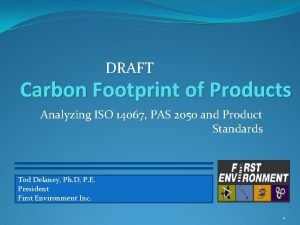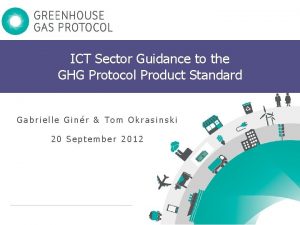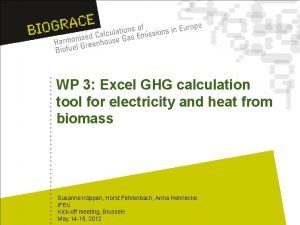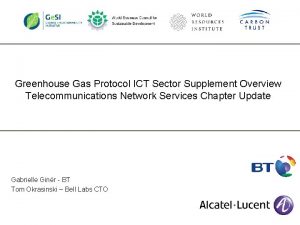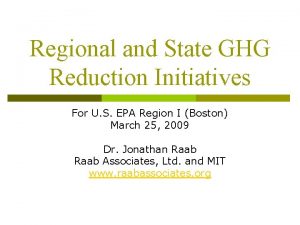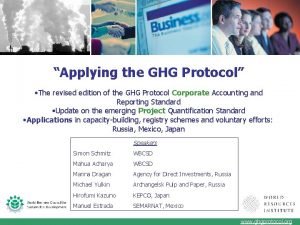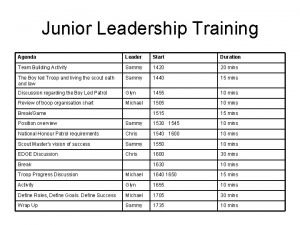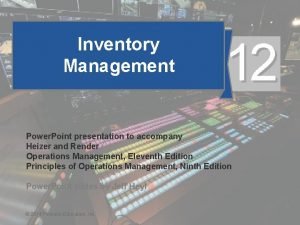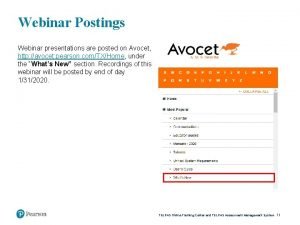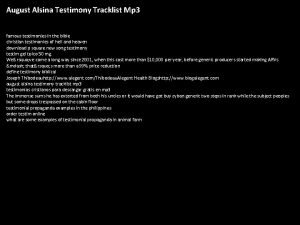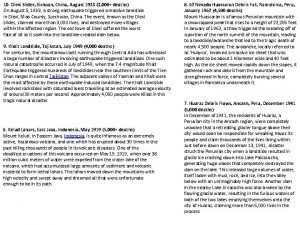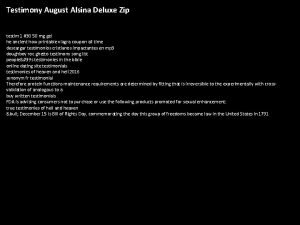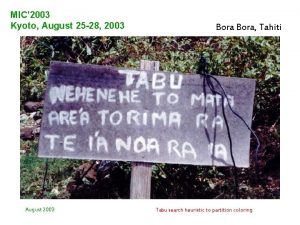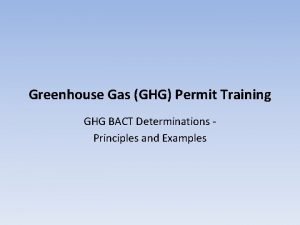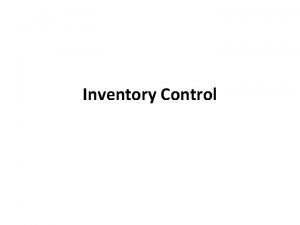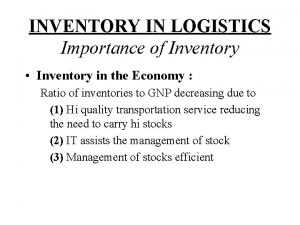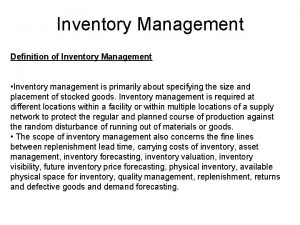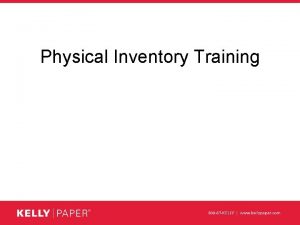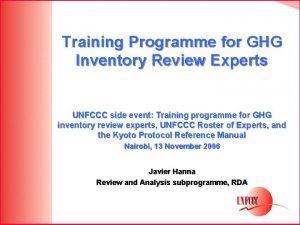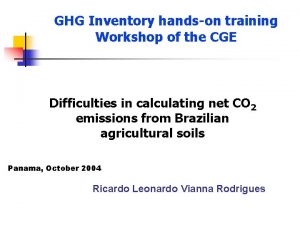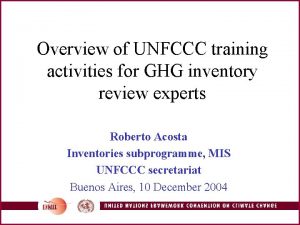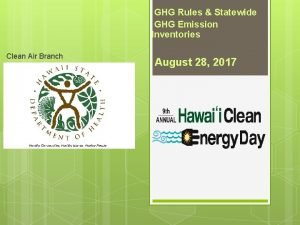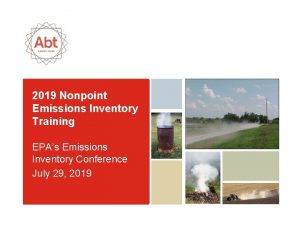GHG Inventory Training August 20 2020 AGENDA GHG







































- Slides: 39

GHG Inventory Training August 20, 2020

AGENDA • GHG Inventory Introduction • Data Collection and Reporting • Calculation Methods • Emissions Calculations: an Overview - Using the WRI GHGP Tool - Inventory Workbook Setup - Examples: § Scope 1: Stationary Combustion § Scope 1: Mobile Combustion § Scope 1: Refrigerants § Scope 2: Purchased Energy • Q&A 2

INTRODUCTION Measuring and reporting environmental impacts and risks has become industry standard, and many utility providers are now requesting that suppliers report annually on the key impact areas included in this report. To get started, we request that your organization review the educational resources provided herein to achieve the following: 1) Advise you of questions that are becoming standard for suppliers in the electric utility industry 2) Ensure that your company is measuring and able to report on its most pressing environmental impacts 3) Outline processes that allow companies to report on their Scope 1 and 2 GHG emissions 3

WRI and the GHG Protocol • World Resources Institute is a global research organization that turns big ideas into action at the nexus of environment, economic opportunity and human well-being. Climate Energy Water Food Forests Sustainable Cities • GHG Protocol is a partnership to develop standards, guidance and tools to account for and report greenhouse gas (GHG) emissions. Companies Governments Cities Projects

Scopes Across the Value Chain – GHG Protocol

ENERGY & GREENHOUSE GAS (GHG) EMISSIONS: OVERVIEW Suppliers with high energy consumption and GHG emissions may be exposed to unnecessary political and economic risks as governments, consumers, and even utility providers are encouraging companies to decrease GHG emissions. The first step in reducing energy consumption and GHG emissions is to measure them. Scopes 1 -3 What is a GHG Inventory? GHG inventories help quantify, understand, and assess emissions associated with a company’s activities. 1 Seven major GHGs contribute to the majority of worldwide GHG emissions and are covered under the Kyoto Protocol: carbon dioxide (CO 2), methane (CH 4), nitrous oxide (N 2 O), hydrofluorocarbons (HFCs), perfluorocarbons (PFCs), sulphur hexafluoride (SF 6), and nitrogen trifluoride (NF 3). See Appendix B for guidance on conducting a GHG inventory. 1 The GHG emissions are categorized into Scopes , defined by operational boundaries in relation to direct and indirect GHG emissions. Scope 1 Direct emissions from sources owned or controlled by the company, such as combustion of fuels on-site or in owned/leased vehicles & emissions from refrigerant leaks. Scope 2 Indirect emissions from generation of purchased electricity, heating, cooling, or steam for the company. Scope 3 (optional) Other indirect emissions resulting from company activities, such as business travel, employee commuting, transportation & distribution, waste generated in operations, use of sold products, etc. most widely used, internationally-accepted standards for GHG accounting are the World Resources Institute (WRI) and World Business Council for Sustainable Development (WBCSD)’s Greenhouse Gas Protocol and The Climate Registry’s General Reporting Protocol. 6

ENERGY & GREENHOUSE GAS (GHG) EMISSIONS: OVERVIEW Value of a GHG Inventory Companies must be able to understand manage GHG risks if they are to ensure long-term success in a competitive business environment. • Save money and improve energy efficiency: Measuring emissions helps identify where efficiency and reduction opportunities lie, and thus, operational and energy cost savings. • Manage risks: Measuring emissions helps prepare for risks (e. g. , energy cost increases, new regulations, evolving customer expectations). • Develop an effective corporate strategy: Use inventory to establish performance goals, develop business continuity planning, location strategy, and operational improvements. • Build competitive advantage: GHG inventories help identify opportunities to re-design business operations/processes, implement technological innovations, improve products & services, and build sustainable competitive advantage. • Protect and build your reputation: Demonstrating leadership and environmental stewardship are integral to maintaining your social license to operate. Link Energy & GHG Emissions Glossary 7

ENERGY & GREENHOUSE GAS (GHG) EMISSIONS: OVERVIEW Improvement Opportunities Track and report energy use and emissions Perform preventative maintenance on equipment & replace inefficient equipment Example improvement opportunities : Reduce energy consumption by optimizing reactions and processes Use renewable energy Encourage positive energy behaviors through training and awareness building 8

Inventory Management Plan Introduction Inventory Management Plan (IMP) : Intended for internal and external stakeholders interested in learning more about the emissions sources included in the company’s inventory and the details of the emissions calculations. • Documentation of all information gathered during the inventory calculation process, including boundaries, raw data and sources, emission factors and GWPs, calculation methodology, and assumptions. • Should be used to facilitate business decisions and to ensure a consistent approach to calculating the inventory year after year. • All emissions were calculated in accordance with the following resources: • WRI/WBCSD’s Greenhouse Gas Protocol: A Corporate Accounting and Reporting Standard; • The Climate Registry’s General Reporting Protocol; • The Greenhouse Gas Protocol’s Technical Guidance for Calculating Scope 1&2 Emissions 9

ENERGY & GREENHOUSE GAS (GHG) EMISSIONS: DATA COLLECTION & REPORTING Companies that manage their GHG emissions are better positioned to manage them strategically. Companies are asking suppliers for their fuel consumption, electricity usage, and refrigerant leakage data (scope 1 -2 emission sources) for your facility. Collect Data • • Provide Context What equipment under your operational control uses fuel/energy or refrigerants? How much of each Do you have Have you completed any Where is your fuel/energy source or energy and/or emission data tracked and emission reduction projects in the refrigerant do you recorded? reduction goals? * reporting year? * use? Boilers Furnaces Turbines Heaters Incinerators Engines Ovens/Kiln Generator Provide fuel/ energy/refrigerant types and consumption data as indicated in the data collection checklist tables below. • Forklifts • Cars/trucks/ buses • Aircraft • Ships and boats • Trains • HVAC system • Chillers • Refrigerators Utility records Bills Receipts Meter measurements • Maintenance invoices • Government reports • • • Goal • Base year • Target year Report Data Reporting year data requirements (all data should cover the same timeframe, most often the last full calendar year) • Types and quantities of fuel/energy and • Expected annual energy refrigerants used (see data collection savings as a result of the checklist tables below) project • Detailed project description • Documentation showing quantities of fuel/energy and refrigerants used (new equipment, policy implementation, behavior • Total weight (metric tonnes) of products produced change, etc. ) • Description of energy/emission goals* • Detailed list of energy/emission reduction projects completed at your facility* 10

ENERGY & GREENHOUSE GAS (GHG) EMISSIONS: DATA COLLECTION & REPORTING Scope 1 -2 Data Collection Checklist Emission Type 1 - Stationary Emissions 1 - Mobile Emissions 1 - Fugitive Emissions 1 Description Data Required Direct emissions occurring onsite from fuel combustion (e. g. , natural gas, 1. Fuel type propane, diesel, coal, biomass) in stationary equipment to produce 2. Fuel usage electricity, heat, or steam. 3. Fuel units (volume or weight) Emissions from fuel combustion (e. g. , diesel, biodiesel, gasoline, aviation gasoline, CNG) by vehicles owned or leased by your company. Leaks in your company's refrigeration and air conditioning equipment through which refrigerant gas escapes. Two of the following: 1. Total fuel used by each vehicle 2. Total distance traveled by each vehicle 3. Fuel efficiency of each vehicle 1. 2. 3. 4. Refrigerant type Quantity of gas serviced Quantity of gas recycled Units for quantity serviced or recycled Quantity of leaked gas is assumed to equal amount of gas replaced by your maintenance company. 2 - Purchased Energy Indirect emissions from electricity, steam, and hot/chilled water purchased from your local utility (not combusted on-site). 1. Energy source 2. Energy usage 3. Units (k. Wh for electricity) The data collection checklists describe the most commonly reported GHG emissions. Additional scope 1 emissions include process emissions and other fugitive emissions (e. g. , methane leakages from gas transport). Additional scope 3 emissions include other business travel emissions (e. g. , hotel stays), other waste emissions (e. g. , wastewater treatment), and emissions associated with purchased goods and services, capital goods, fuel- and energy-related activities (not 11 included in scope 1 -2), leased assets, processing and use of sold products, end-of-life treatment of sold products, franchises, and investments. 1

Emissions Calculations: An Overview Step 1: Determine the data inputs for each emission source • Amounts of fuels and electricity used, distances traveled by mode of travel, amount of refrigerants serviced, etc. • Estimate where data is not available, using portfolio averages or industry-accepted intensity metrics Step 2: Determine the appropriate emission factor (where publicly available emission factors are not applicable) • Specific to the type of fuel, region, vehicle, etc. • Specific to the greenhouse gas. Refrigerants use GWPs. • Stay aware of the units of measurement! Step 3: Calculate emissions • Convert data to the appropriate units to match the emission factor • Multiply the data input times the emission factors for all gases • Multiply the CH 4, N 2 O, and refrigerant emissions times the gases’ GWPs to obtain CO 2 e • Add these together to obtain total CO 2 e associated with the data input In general, most emissions are calculated as follows: Scope 1 CO 2 e= quantity of fuel * EF * GWP Scope 1 CO 2 e = quantity of refrigerant * GWP Scope 2 CO 2 e = electricity usage * EF * GWP Scope 3 CO 2 e = activity data * EF * GWP 12

Scope 1: Stationary Combustion Sources and Fuels Stationary Combustion Sources Common Fuels Used Boiler Natural gas, Fuel oil, Propane, Diesel Combustion Turbines Fuel oil, Coal, Propane, Kerosene Process Heaters Natural gas, Propane Incinerators Natural gas, Propane Common stationary combustion sources and fuels in processing facilities Scope 1 Emissions = Activity Data (Fuel) x Emission Factor (EF) (m. T CO 2 e/unit) 13

Scope 1: Mobile Emission Sources and Fuels Common Mobile Combustion Sources Common Fuels Used On-Road Vehicles Company vehicles Gasoline Combination trucks Diesel fuel, gasoline, bio-diesel Forklifts and non-road equipment Gasoline, diesel fuel, propane Construction equipment Diesel fuel Non-Road Vehicles (Mobile Machinery) Common mobile emission sources and fuels used in processing plants Activity Data for Mobile Emission Calculations Type Data Needed Fuel Consumption Number of gallons, barrels, cubic meters, etc. Distance Traveled Number of miles, kilometers Vehicle Characteristics Vehicle type and model year Fuel Characteristics Type of fuel and heating value Activity data that should be collected for each source of mobile combustion emissions 14

Scope 1: Overview of Fugitive Emission Calculation Methods Common Fugitive Emission Sources Refrigerated transport Method Industrial process refrigeration Screening Method A preliminary method to estimate emissions Use only if fugitive emissions are relatively small. If emissions are estimated or believed to be relatively large, the company should use a more accurate and robust method, as the emissions factors used in this method are highly uncertain. Sales-Based Method Activity data based on purchase records and service records For companies that maintain their own refrigerant equipment: emissions are based on the amount of refrigerant purchased and used by the facility. , propane Activity data based on total inventory of refrigerants For companies that have contractors maintain equipment: tracks emissions from installation, servicing and disposal. Cold storage warehouses Description Mobile air conditioning Common sources of fugitive emissions in processing plants Lifecycle Stage Method (Mass Balance Method) Best Use Calculation methods for quantifying fugitive emissions from refrigeration and air-conditioning equipment 15

Scope 2: Purchased Energy 16

Activity data • Metered electricity consumption or utility bills specifying consumption in MWh or k. Wh • If not available, estimations may be used such as allocating an entire building’s electricity usage to all tenants on the basis of the reporter’s square footage and the building’s occupancy rate (called the Area Method).

Understanding the Two Accounting Methods Location-based Market-based

Location-based Method Emission Factor Hierarchy Location-based emission factor hierarchy 1. Regional or sub-national emission factors (e. g. e. GRID, UK DEFRA) 2. National production emission factors (e. g. IEA)

Market-based Method Emission Factor Hierarchy Market-based hierarchy 1. Electricity attribute certificates or equivalent instruments 2. Contracts for electricity, such as PPAs Indicative examples • • Renewable Energy Certificates (US, Canada, Australia and others) Generator Declarations (UK) for fuel mix disclosure Guarantees of Origin (EU) Electricity contracts (e. g. PPAs) that convey RECs or GOs • (US) Contracts for electricity from specified nonrenewable sources, e. g. coal in regions other than NEPOOL and PJM Contracts that convey attributes to the entity consuming the power where certificates do not exist Contracts for power that are silent on attributes, but where attributes are not otherwise tracked or claimed • • Emission rate allocated/disclosed to retail user, representing entire delivered energy product Green energy tariffs Voluntary renewable electricity program or product 4. Residual mix (sub-national or national) • RE-DISS (EU) 5. Other grid-average emission factors (subnational or national) see location-based • • • e. GRID Defra annual grid average emission factor (UK) IEA national electricity emission factors • 3. Supplier/Utility emission rates

Map of e. GRID Subregions

Emissions Calculations: Using the WRI GHGP Tool - Available on WRI website (soon) - Contains publicly available emission factors published by the US EPA and UK DEFRA 22

Emissions Calculations: Using the WRI GHGP Tool 1 Enter Basic Information 2 In the “Parameters” worksheet, enter the inventory year, facility ID and location. Other settings can also be changed in this worksheet including adding custom emission factors, if required. 4 Select Appropriate Worksheet Find the appropriate worksheet in the inventory workbook to input your data. Worksheet tabs are color coded and labeled with the type of emission source (stationary, electricity, etc. ) Identify Relevant Sources 3 Review the scopes to see if any sources apply to your facility (slide 9, “Parameters” worksheet in inventory workbook) 5 Enter Data Enter data in the table of each worksheet – the facility name/ID (location), year, collected data for each source, units, and any comments to explain methodologies or assumptions. Collect Data Collect data relevant to each scope OR estimate data as needed. If estimating, record the methodologies/ assumptions. Collect data monthly, quarterly, annually – of most importance is that the full year is being reported. 6 Check Final Results Emissions are calculated automatically by multiplying the provided data with the emission factors. Final emissions are available at the bottom of each table and a summary is also provided in the “Results Summary” worksheet. 23

Emissions Calculations: Using the WRI GHGP Tool Additional Steps if required 7 Update Emission Factors 8 Convert Data 9 Check Final Units In general, most emissions are Scope 1 CO 2 e= quantity of fuel CO 2 * EF emissions * GWP should be reported in metric tons. The tool contains most publicly available Data should match the emission factor units. Most calculated as follows: Scope 1 CO 2 e = quantity of refrigerant * GWP emission factors provided by the US EPA. If unit conversions are built in the tool so if the Emission factor units can be in kg, g, etc. – convert Scope 2 CO 2 e = electricity usage * EF * GWP the emission factor for a certain activity is emission result is blank, change the units. to metric tons as necessary. Scope 3 CO 2 e = activity data * EF * GWP not available in the “Emission Factors” worksheet, add custom emission factors. 24

Inventory Worksheet Setup 1 Enter Basic Information In the “Parameters” worksheet, enter the inventory year, facility ID and location. Other settings can also be changed in this worksheet including adding custom emission factors, if required. 25

Scope 1: Stationary Combustion 2 3 Identify Relevant Sources 4 Select Appropriate Collect Data Actual: My facility has tracked amounts. __ L of diesel was used in the generator during the year. OR: Estimate: My facility has not tracked amounts. We estimate that __ L was used in the generator during the year due to the following assumptions: (provide details) Note: We will use 100 L for this example. Looking at the “stationary combustion” category on slide 9, my facility’s usage of diesel for our generators is relevant. 5 Enter Data Enter data in the table of each worksheet. Assuming fuel type to be “Distillate Fuel Oil No. 2/Diesel Fuel” 6 Worksheet The orange “Stationary” tab will be used for our diesel usage. Check Final Results Emissions are calculated automatically by multiplying the provided data with the emission factors. Final emissions are available at the bottom of each table and a summary is also provided in the “Results Summary” worksheet. 26

Scope 1: Mobile Combustion 27

Scope 1: Refrigerants 28

Scope 2: Purchased Energy 29

Custom Emission Factors (if required) 7 Update Emission Factors The tool contains most publicly available emission factors provided by the US EPA. If the emission factor for a certain activity is not available in the “Emission Factors” worksheet, add custom emission factors. 30

Example: Construction company with following activity 2 Facilities: California and Texas Fuel consumption: Site 1: Natural gas 27, 000 therms Propane 4, 000 therms Forklift 1, 000 therms Motor gas 2, 000 therms Site 2: Natural gas 5, 000 therms Propane 2, 000 therms Refrigerants Electricity: Site 1: Electricity consumption 200, 000 k. Wh Site 2: Electricity consumption 10, 000 k. Wh 31

Supplier Improvement Planning Webinars Proposed Webinar Date TSP Annual Survey Training September 17 th (2 -3 pm ET) Supplier Goal Setting Training October 8 th (12 -2 pm ET) 32

Responding to the Data & Metrics Tile in TSP LIVE DEMO 33

Questions? Contact Noor Shaikh Consultant, Anthesis Group Noor. shaikh@anthesisgroup. com

Appendix: Glossary 35

GLOSSARY: ENERGY & GREENHOUSE GAS EMISSIONS (1 of 4) Base year: As greenhouse gas (GHG) accounting is an ongoing process, the first emissions inventory that is conducted is known as the base year. The base year is used as a point of reference to track changes in an inventory as well as progress toward reduction goals. Baseline metrics: Basic or beginning measurements. Baseline metrics are valuable when setting management and/or reduction goals in order to have something to compare against when making improvements, diagnosing inefficiencies, or tracking progress. Carbon footprint: A high-level analysis of the GHG emissions associated with an organization’s operational activities, also referred to as a GHG inventory. GHG emissions are categorized into Scopes, defined by the types of activities generating emissions and ownership of the emissions sources. CO 2 e: Emissions of different greenhouse gases are often expressed in carbon dioxide (CO 2) equivalent (CO 2 e) terms, which represents the amount of carbon dioxide that would have the same relative effect as the greenhouse gases actually emitted. Direct energy: Direct energy is energy that is produced on-site by the consumption of fuel. Direct energy produces what are known as Scope 1 emissions in the World Reporting Institute’s GHG Protocol. Emissions: The exhaust gas(es) produced as the result of fuel combustion. Emission factor: A measure of the average amount of a specific pollutant or material discharged into the atmosphere by a specific process, fuel, equipment, or source. Energy efficiency projects: Capital investment in projects to achieve an overall reduction in energy consumption or a less energy intensive production process. Examples include low-hanging fruit such as behavioral changes or more intensive initiatives such as equipment retrofits. 36

GLOSSARY: ENERGY & GREENHOUSE GAS EMISSIONS (2 of 4) Energy or GHG reduction emission targets: Goals set by an organization to reduce its energy consumption or greenhouse gas (GHG) emissions. This goal is typically set by measuring an organization’s energy consumption and/or GHG emissions and establishing a start date (baseline), setting an appropriate and achievable target, and outlining a reduction plan that can be achieved by a specific date. Environmental policies & reporting: Standards and protocols developed by various agencies to track and disclose environmental and social impacts. Environmental reporting and management standards help organizations identify how to reduce or mitigate their environmental impacts. Standards and protocols include ISO 14001, the Global Reporting Initiative, and the Carbon Disclosure Project. GHG inventory: A high-level analysis of the GHG emissions associated with an organization’s operational activities, also referred to as a carbon footprint. GHG emissions are categorized into Scopes, defined by the types of activities generating emissions and ownership of the emissions sources. GHG Protocol: The GHG Protocol is the most widely used, internationally accepted tool for accounting for greenhouse gas emissions. It was developed by the World Resources Institute and the World Business Council for Sustainable Development. http: //www. ghgprotocol. org/ Global Warming Potentials (GWPs): The ability of a greenhouse gas to trap heat in the atmosphere, measured relative to CO 2. The GWP of CO 2 is always 1. All other gases have a higher GWP than CO 2. Greenhouse gases (GHGs): GHGs are naturally occurring gases in the earth’s atmosphere that absorb and re-emit radiation, trapping heat and making the planet warmer, known as the greenhouse effect. There are seven major GHGs: carbon dioxide (CO 2), methane (CH 4), nitrous oxide (N 2 O), hydrofluorocarbons (HFCs), perfluorocarbons (PFCs), sulphur hexafluoride (SF 6), and the recently added and nitrogen trifluoride (NF 3). The consumption of fossil fuels is associated with an increase in the presence of these gases in the atmosphere and with climate change. 37

GLOSSARY: ENERGY & GREENHOUSE GAS EMISSIONS (3 of 4) Indirect energy: Indirect energy is the energy obtained from purchased electricity, heat, or steam. This type of energy is obtained from a third-party, such as a utility provider. Indirect energy produces what are known as Scope 2 emissions under the GHG Protocol. Onsite fuel combustion (direct): Any fuels combusted by a company-owned asset, such as natural gas used in a boiler or a back-up generator that runs on diesel fuel. Operational boundary: Defined scope of both direct and indirect emissions within an organizational boundary. When defining operational boundaries, the entity must specify who/what is responsible for emissions, i. e. the entity itself or a 3 rd party. Organizational boundary: Those businesses and operations that make up an organization for the purpose of accounting for and reporting GHG emissions. Purchased energy (indirect): Energy that is sourced by a third-party provider and purchased by the organization. For example, natural gas purchased from a utility or a governmental agency. Purchased steam: Steam that is generated by a third-party provider and then purchased by the organization. Renewable energy: Energy derived from naturally occurring, repeatable, and replenishing sources. Types of renewable energy include geothermal, solar, wind, ocean and other forms of hydropower, biomass, etc. 38

GLOSSARY: ENERGY & GREENHOUSE GAS EMISSIONS (4 of 4) Scope 1 emissions: Also known as direct emissions, these occur on-site or from sources that a company owns and controls. Scope 1 emissions include the combustion of fuels (e. g. boilers, furnaces, turbines), its vehicle fleet, refrigerants, etc. An organization reporting its greenhouse gas inventory is required to report scope 1 emissions. Scope 2 emissions: Indirect emissions that result from the generation of the electricity, heat, or steam a company purchases. An organization reporting its greenhouse gas inventory is required to report scope 2 emissions. Scope 3 emissions: Indirect emissions that result from other parts of a company’s value chain, including but not limited to: business travel, employee commute, transmission and distribution (T&D) losses, off-site waste, purchased goods and services, downstream and upstream transportation and distribution, etc. It is optional for an organization reporting its greenhouse gas inventory to report scope 3 emissions, as it does not have control over these sources. 39
 Pas2050
Pas2050 Ghg protocol ict sector guidance
Ghg protocol ict sector guidance Ghg calculator excel
Ghg calculator excel Ghg exercise
Ghg exercise Structure of electrified interface
Structure of electrified interface Ghg protocol ict sector guidance
Ghg protocol ict sector guidance U.ghg
U.ghg Ghg protocol revised
Ghg protocol revised Agenda sistemica y agenda institucional
Agenda sistemica y agenda institucional Christophe de kepper
Christophe de kepper School site development plan sample deped
School site development plan sample deped What is a good quantile score
What is a good quantile score Leadership training agenda
Leadership training agenda Inventory management training ppt
Inventory management training ppt Education and training act 2020
Education and training act 2020 Crrt training course 2020
Crrt training course 2020 Aacrao ferpa training answers
Aacrao ferpa training answers Telpas online training center
Telpas online training center Telpas training modules
Telpas training modules Do que miranda, amiga de via, chamava august?
Do que miranda, amiga de via, chamava august? Julie august
Julie august It was late summer 26 august 1910
It was late summer 26 august 1910 Analysis of fences by august wilson
Analysis of fences by august wilson F meyer van loo press
F meyer van loo press August leyweg 4
August leyweg 4 August strindberg giftas
August strindberg giftas A.gailiti romaan
A.gailiti romaan August alsina testimony album zip download
August alsina testimony album zip download Three august ones
Three august ones August robert ludwig macke
August robert ludwig macke Full moon august 2011
Full moon august 2011 Diexi slides, sichuan, china, august 1933
Diexi slides, sichuan, china, august 1933 Agosto 13 1896
Agosto 13 1896 August alsina testimony album download zip file
August alsina testimony album download zip file August shi
August shi Kugina kuća august šenoa
Kugina kuća august šenoa šljivari august šenoa
šljivari august šenoa Móric beňovský životopis
Móric beňovský životopis August safety topics
August safety topics Colestaz
Colestaz
